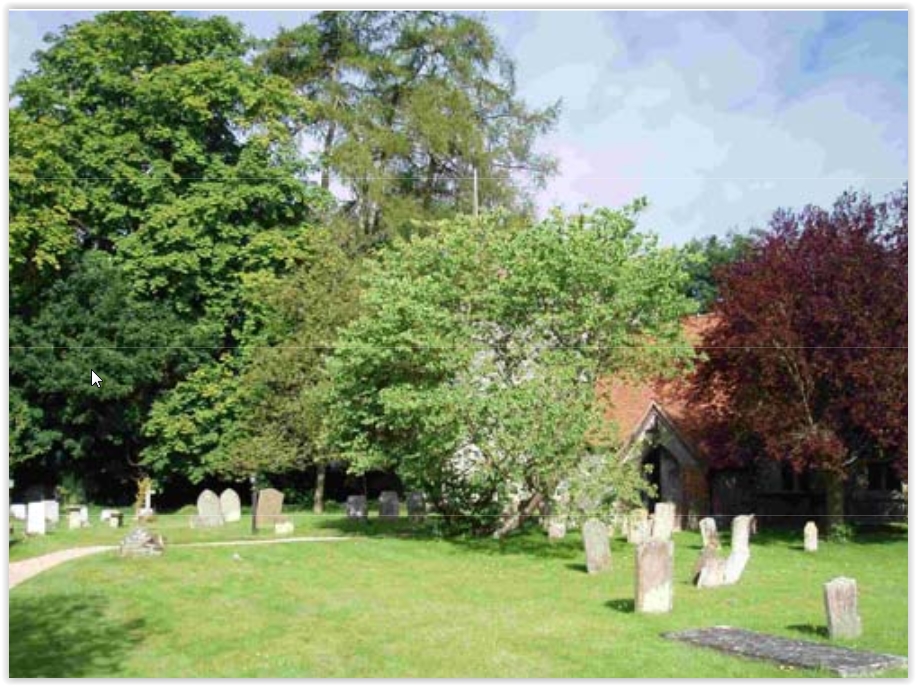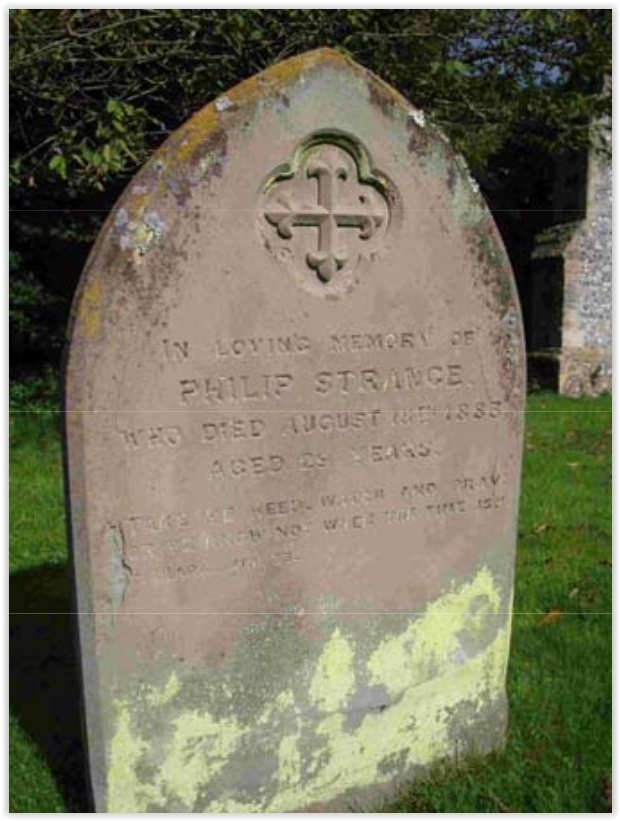... the blacksmith, having taken in, just for luck as it were, yet another reef in his snake buckle belt, prepared to open the attack. It so happened that at the end he was to bowl the ground behind the wicket was level for a few yards and then sloped away rather abruptly, so that it was only during the last three or four intensive, galvanic yards of his run the blacksmith, who took a long run, was visible to the batsman or indeed anyone on the field of play except the man stationed in the deep field behind him. This man saw nothing of the game except the blacksmith walking back dourly and the blacksmith running up ferociously, and occasionally a ball driven smartly over the brow of the hill in his direction.
A G MacDonnell, England, Their England
Philip Strange followed his great-great-grandfather (Thomas), great-grandfather (John), grandfather (Philip) and father (James) as the Turville Heath blacksmith. He was born on 10 September 1854 at The Hatch, Turville Heath. He had an elder sister Susanna Mary and, eventually, three younger siblings, William, Ann and James. His mother died in 1864 and his father in 1869. So, in his mid-teens, Philip Strange took over as Turville Heath’s blacksmith.
No doubt Philip did a great deal of work for the Turville Park estate. Therefore, when Stafford O’Brien Hoare took over in 1880 and formed the cricket club, Philip was eager to please his new employer by participating in the team.
After years at the anvil, Philip had a good eye and was capable of lusty blows. His was, therefore, an invaluable source of quick runs in the later part of Turville’s innings. With his strength and fitness, he was also likely to bowl fast, very fast. We shall probably never know whether he was Turville’s opening bowler (or even its first ever bowler).
But if we close our eyes, we can imagine him running ferociously over the brow of the hill that leads down to Turville Park farm to bowl to trembling village batsmen.
Turville Spirit
In his first three years in the team, Philip Strange had probably had both good and bad days but even on the worst of those days he enjoyed the Turville spirit. The banter with team mates and opposition alike; the despairing look when the captain dropped a slip catch or the opposition umpire denied him an obvious LBW; warm beer after the match before walking briskly back across Turville Heath to the Hatch.
Philip was selected as usual to play on 23 August 1883. Although the scorebook was lost, Turville tradition (which started veryearly) meant that the middle of August usually meant one of the two matches against Stonor. There is now, and was then, no greater rivalry in the sporting calendar than in this local derby. Therefore, there is a good chance that Turville played Stonor on 23 August 1883.
It was a very hot day with the possibility of a thunderstorm later. Philip had a busy morning shoeing horses for a local farmer and repairing a plough for Turville Park estate. His young family had also demanded his attention. He ate a quick lunch and downed a pint of home brewed beer quickly before rushing across the Heath to the Turville Park and the cricket ground. He was late, but not the last to arrive. His kit was complete (unusual) and creased (as usual), but not as creased or stained as that of some others (nothing changes).
Captain’s Orders
Turville won the toss and elected to field. “We’re better at chasing a target”, explained the captain who also decided to experiment by opening the bowling with two youngsters who were visiting the estate. “Give them a chance”, he said. But who were ‘them’? The young visitors or the visiting team.
The Stonor openers scored quickly and Philip Strange and his fellow Turville fielders were condemned, on a very hot afternoon, to an hour of chasing the ball into the adjacent corn field.
Eventually, the captain threw Philip the ball. “We need a wicket”, were his only instructions. Philip walked dourly to his mark, turned and began his ferocious run up over the brow of the hill to the wicket. We don’t know whether it was his first ball which was his last or whether he bowled a long spell before he collapsed and died of heart disease.
We can only speculate whether his death was caused by his earlier exertions at the anvil or in the field, by the strains of his long run up the hill on a hot afternoon or yet another dropped catch or appalling LBW decision.
The Last Blacksmith
Philip Strange is buried a few yards from the door of Turville church. His death devastated his young wife and family as well as his siblings and they moved away from Turville Heath. Philip was probably the last blacksmith in Turville Heath. The Hatch is now the expensive home of a commuter who also plays cricket for Turville Park.
We cannot be sure that this story reflects exactly what happened on 23 August 1883 and we have no record of Philip Strange’s batting and bowling records for Turville. We can be sure, however, that he enjoyed his cricket — he made good friends and was good company. He always wanted to win, but not too easily (unless the opponents were Stonor) and was never too downhearted after a defeat (even if the opponents were Stonor). He always forgave those who dropped catches off his bowling and was sometimes known to buy a beer for an opposition umpire who turned down his LBW appeals.
We can also be sure that he would have wanted a place in a Turville team to play Gloucestershire - as long as the match was played on the 1883 wicket. Given the batsman’s paradise prepared by John Leefe and John Hancock, today he might have preferred to watch other bowlers being hit into corn fields. There is, after all, only so much Turville spirit in a fast bowler.
With much appreciation to Mike Strange and his study of the surname Strange and its derivatives in Buckinghamshire and elsewhere and to those who have contributed to that study. Further information is available at: www.yourtotalevent.com/people/idxpepl.htm.
And with apologies to A G MacDonnell
Published in the Turville Park Cricket Club programme for the Tim Hancock Befit match on Sunday 5th June 2005. The match wasbetween Turville Park Cricket Club and Gloucestershire County Cricket Club in Turville CC’s anniversary year of 1880-2005.



